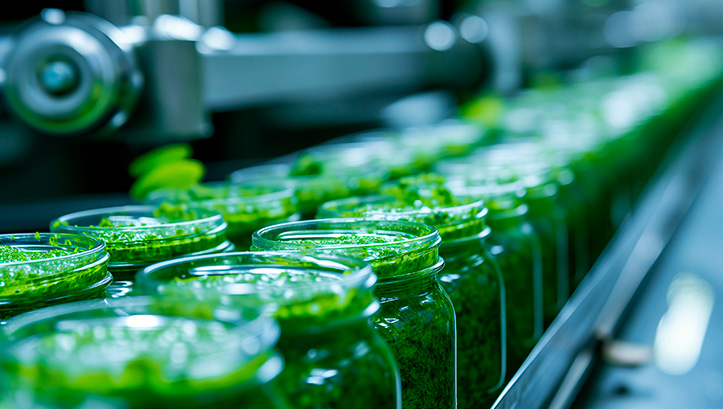The sauces and creams industry encompasses a wide variety of products ranging from traditional sauces such as tomato sauce, mayonnaise and ketchup, to more specialized sauces and creams such as salad sauces, hot sauces, pasta dressings, sauces for desserts and more.
The production of pasteurized or refrigerated sauces and creams involves a specific process to guarantee food safety and product quality that consists of the following steps:
- Selection of ingredients: High quality ingredients are chosen, such as fresh tomatoes, herbs, oil, vinegar, spices, etc., depending on the type of sauce or cream you want to make.
- Washing and preparation: Fresh ingredients, such as tomatoes, peppers or herbs, are washed, peeled and cut according to the needs of the recipe.
- Cooking: The ingredients are cooked in large boilers or tanks at controlled temperatures. Cooking allows the flavors to mix and the sauce or cream to reach the desired consistency.
- Mixing and Homogenizing: Sauces and creams are mixed and homogenized to ensure uniform texture and equal distribution of ingredients.
- Pasteurization (for packaged sauces): After cooking and blending, pasteurized sauces undergo a pasteurization process. This involves heating them at specific temperatures for a certain time to eliminate pathogenic microorganisms and ensure their safety. Then they cool quickly.
- Chilling (for refrigerated sauces): In the case of refrigerated sauces, instead of pasteurization, they are quickly cooled to maintain their freshness and texture. These sauces are packaged in refrigerated containers and must be kept refrigerated throughout their shelf life.
- Packaging: Pasteurized sauces are packaged in hermetically sealed containers, such as glass jars or plastic bottles, before undergoing an additional pasteurization process.
- Refrigerated sauce packaging: Refrigerated sauces are packaged in containers that offer an airtight seal and refrigerated environment. These products have a shorter shelf life than pasteurized sauces.
- Labeling and coding: Labels are applied to packaging with product information, such as ingredient list, nutritional information, expiration dates, and lot codes.
- Storage: Finished products are stored in suitable conditions, either in cold rooms or at room temperature, depending on the type of sauce or cream.
The production process may vary depending on the type of sauce or cream that is made. Some sauces require additional processes, such as hot packaging or the use of high-pressure technologies, to ensure food safety and product shelf life. The machinery used, such as boilers, mixers and pasteurization systems, is essential to ensure an efficient and safe production process.
The production of sauces and creams at an industrial level involves the use of specialized machinery to mix, cook, bottle, label and package these products efficiently and consistently. Some of the most common machines and equipment used in the sauces and creams industry are:
- Mixers and agitators: These equipment are used to combine and homogenize ingredients. Depending on the size of the production, they can be batch mixers or continuous mixers. Mixers help ensure that all ingredients are evenly distributed.
- Cookers and cooking pots: They are used to cook ingredients and mix them. Cooking pots can be of different sizes and types, such as pressure cookers or large-capacity industrial cookers.
- Heat exchangers: These equipment allow precise control of temperature during the cooking and heating process. They are essential for pasteurizing or sterilizing sauces and creams to ensure their food safety and increase their shelf life.
- Homogenizers: Homogenizers are used to break down solid particles and achieve a smooth and uniform texture in sauces and creams. They also help improve the mixing of ingredients.
- Transfer pumps: Used to move sauces and creams from one location to another in the production process, such as from the mixer to the cooking pots or from the cooking pots to filling equipment.
- Coolers: These equipment allow sauces and creams to be quickly cooled after cooking or pasteurization to maintain their freshness and quality.
- Filling and packaging machines: These machines are used to fill sauces and creams into specific containers, such as glass jars, plastic bottles or bags. Filling is done precisely and often includes weighing systems to ensure the correct quantity.
- Sealing systems: They are used to hermetically seal containers, which is essential to maintain the freshness and safety of the product.
- Pasteurization or sterilization tunnels: If pasteurization or sterilization is required, specialized tunnels allow filled containers to be subjected to appropriate heat treatment to ensure food safety.
- Labeling and coding systems: These equipment apply labels with product information, expiration dates and lot codes on containers.
- Quality inspection: Visual and quality inspection machines are used to detect any defects in packaging or products.
- Control and automation systems: Industrial machinery is controlled and monitored with control and automation systems to ensure that the process is carried out efficiently and accurately.
The machinery used in the sauces and creams industry can vary depending on the type of product, the scale of production and the specific requirements of the recipe. Investment in adequate processing technology is essential to maintain quality and efficiency in the production of sauces and creams at an industrial level.
Starting from specific specifications in each case, we carry out the design and comprehensive production of Complete Lines that cover the specific needs of each client. Tell us about your needs and we will carry out a personalized project that adapts to your requirements. If you wish, we can work together from the beginning of the activity, renew your equipment or adapt to your new needs. Together, we are stronger. Each Project is unique and personal. Our capacity and experience enable us to tackle any possible project within the Food sector.
